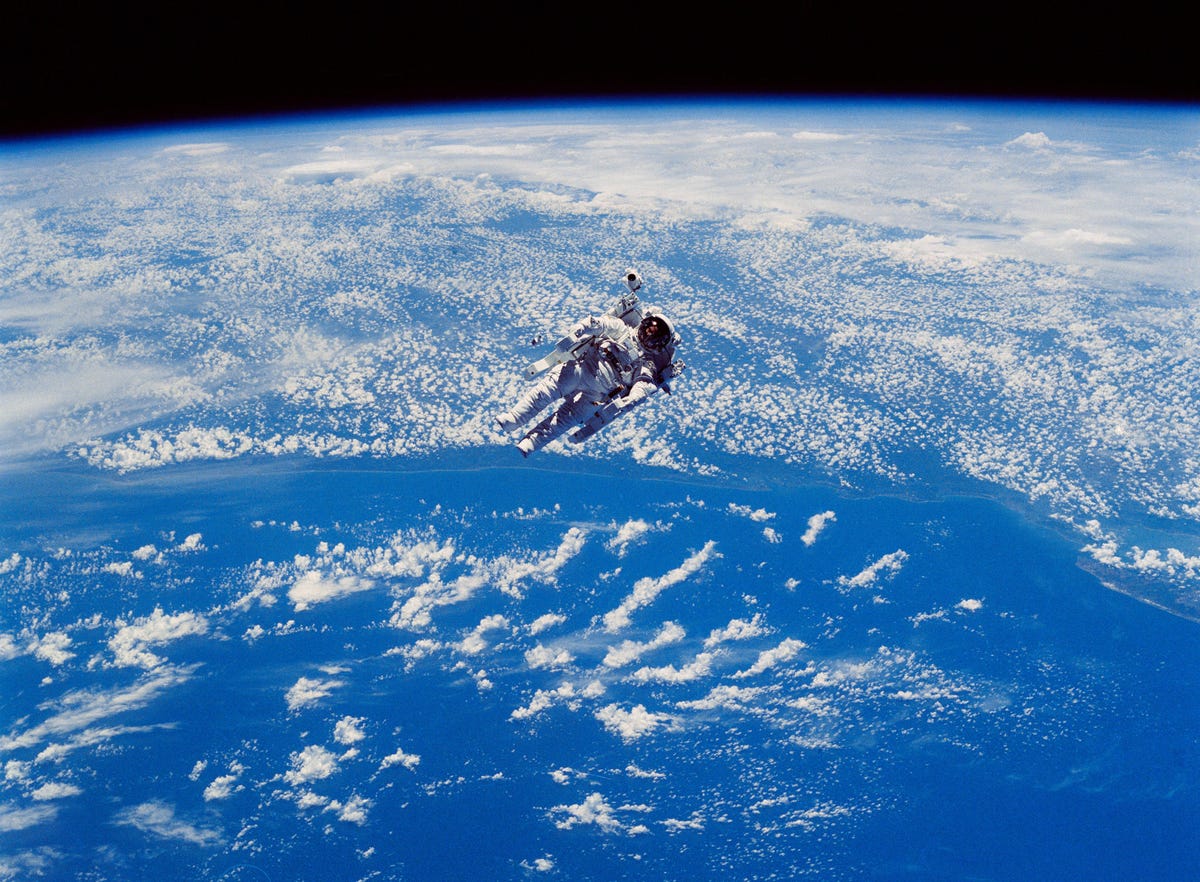11 breathtaking images of NASA astronauts floating in space
Float through an array of breathtaking (and terrifying) images of astronauts in the emptiness of space.

Spacewalk with me
Not at all for the faint of heart, spacewalking is the act of performing activities outside the safety of a spacecraft. It is more officially known as an "extravehicular activity" or EVA.
This image shows Robert L. Stewart on mission STS-41-B flying a few metres away from the cabin of the Challenger Space Shuttle on Feb. 12, 1984, using a jetpack designed specifically for EVAs.
Since the Gemini 4 mission in 1965, NASA astronauts have completed spacewalks on the moon, space shuttles at the International Space Station -- and they've taken some breathtaking images along the way.
The iconic Buzz Aldrin
This image of Buzz Aldrin on the surface of the moon is one of the most iconic in all of Apollo 11's archives -- and NASA's history. Aldrin walked on the moon on July 20, 1969 with crewmate Neil Armstrong. In the image, footprints fill the lunar soil to the left and the leg of the Lunar Module "Eagle" can be seen in the bottom right quadrant.
Of course, the man in the helmet's reflection is Neil Armstrong.
Buzz carries the bags
Buzz Aldrin, the second man to step foot on the moon, backed by the vast darkness of space in an image captured by Neil Armstrong.
It kind of looks like he's waiting for UberSpace to come pick him up and take him home, but his luggage is actually two experimental kits: The Passive Seismic Experiments Package, in his left hand, and the Laser Ranging Retroflector, in his right. This photograph was taken on July 20, 1969.
The first American spacewalk
A golden spacewalk took place in 1965 when Edward H. White II became the first American to float freely in space.
Tethered to the Gemini spacecraft by a 25-foot umbilical line and a 23-foot tether line wrapped in gold tape and wearing a gold helmet visor for protection from the sun's rays, the image perfectly captures the idea that you're always "falling" in space.
Kathryn D. Sullivan's history making spacewalk
A historic moment in NASA's history occurred aboard mission STS 41-G, when Kathryn D. Sullivan become the first American woman to perform a spacewalk. In this image, taken Oct. 11, 1984, Sullivan is checking the latch of the Challenger's Shuttle Imaging Radar-B antenna, which was to be used when imaging Earth.
Issues with the antenna meant that data collection activities during STS 41-G were significantly hampered, resulting in only 20 percent of the planned science data being collected.
Almighty Bruce McCandless flies solo
Bruce McCandless floats atop the Earth, backed by the bleak emptiness of space in history's first untethered spacewalk. He reached a maximum distance of 320 feet away from the Orbiter in the Manned Maneuvering Unit (MMU), propelled by nitrogen gas.
The MMU would be retired in 1984, after a safety review that followed the Challenger disaster.
McCandless was part of mission STS-41-B which flew aboard the Challenger spacecraft in Feburary, 1984.
Mark Lee's terrifying tetherless testing
One hundred and fifty miles above Earth's clouds, Mark C. Lee floats freely in space. On his back is the Simplified Aid for EVA Rescue (SAFER) system, a jetpack that spacewalkers wear in case of emergency. If an astronaut was to accidentally detach from a station or shuttle in orbit, the SAFER system would allow them to rescue themselves. SAFER was a simplified version of the MMU that Bruce McCandless used in 1984.
As yet, no astronauts have had to use the SAFER system.
This image shows Lee testing the kit on Sept. 16, 1994.
Building the International Space Station takes time
In 2007, Michael E. Lopez-Alegria, took a six hour, 40-minute spacewalk aiding construction of the International Space Station. He was commander of Expedition 14, spending 215 days in space and, at the time, taking the record for the longest spaceflight. He currently holds the NASA record for total spacewalk hours at 67:40.
During the expedition, another member of the crew -- Mikhail Tyurin, of Russia -- hit a golf ball from the exterior of an airlock.
Today's office? Space
This is making good use of your office: Space.
Though he's smiling, the fatalist in me almost makes it seem like astronaut Ricky Arnold is ready to fall away from the International Space Station on one of his June 2018 spacewalks.
During this spacewalk, Arnold and Commander Drew Feustel, installed new cameras on the ISS that will provide better viewing opportunities when commercial spacecraft such as the SpaceX Crew Dragon and Boeing Starliner begin launching.
Commander Feustel hangs out at the ISS
Is Commander Drew Feustel just hanging out? Or is he putting the entire International Space Station on his back?
Captured during Feustel's seventh spacewalk in March, 2018, the day's work involved installing wireless communications antennas on the Tranquility module, which generates oxygen for the crew and recycles waste water. It is also the location of one of the space stations toilets.
Tranquil, indeed.
Taking the selfie to new heights
In space, no one can hear you selfie.
Ricky Arnold snaps an image of his reflective helmet at the International Space Station, backed by the Earth, on May 16, 2018.
Instagram would go wild for this, if you get the hashtags right. #space #picoftheday

